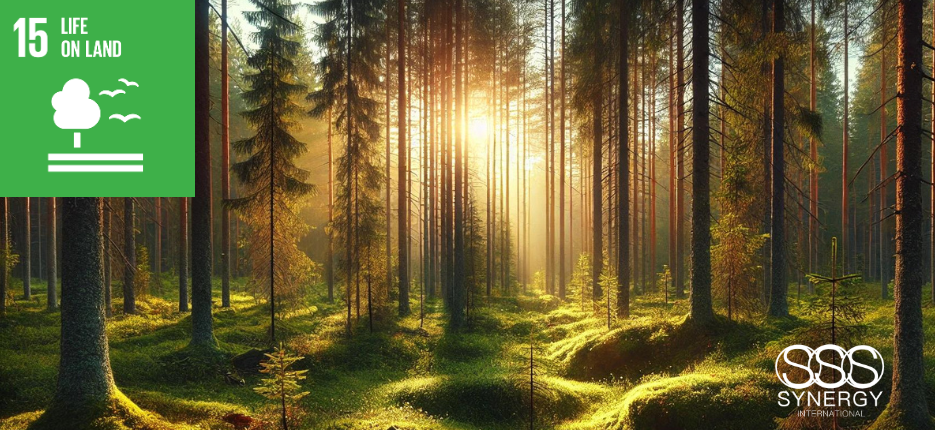Life on Land SDG 15

"Life on Land", SDG 15, is all about protecting and restoring the amazing ecosystems that support life on Earth. Think of it as giving a giant high-five to forests, mountains, and wildlife! 🌲🐅 Whether it's planting trees, safeguarding endangered species, or stopping desertification, this goal ensures we’re looking out for the natural world that sustains us all. Imagine hiking through a lush forest or spotting rare animals in their natural habitat—SDG 15 is here to keep those moments alive and thriving for future generations. Let's keep the wild side of Earth wild! 🌍🌿
COP 16 and COP 29
We are pleased to announce that Synergy International will provide our partners with exclusive access to key legal experts and thought leaders at both Cali and Baku COPs. Details on how to leverage this access will be shared in future editions of GreenWave, ensuring you stay informed and connected with the latest developments in global sustainability governance.
Life on Land SDG - International Treaties and Regimes
The international treaties and regimes that form the legal basis for Sustainable Development Goal 15 - Life on Land SDG (SDG 15), which focuses on life on land, include several pivotal agreements centered around biodiversity conservation, ecosystem preservation, and combating desertification. These treaties have established frameworks for protecting terrestrial ecosystems and ensuring their sustainable management.
1. Convention on Biological Diversity (CBD)
The CBD is one of the foundational treaties underpinning SDG 15. Adopted in 1992 at the Earth Summit in Rio de Janeiro, the CBD aims to conserve biological diversity, promote sustainable use of its components, and ensure fair and equitable sharing of benefits arising from genetic resources. The treaty has broad objectives related to ecosystem management and species protection, aligning closely with SDG 15's goals of halting biodiversity loss and protecting forests and other ecosystems.
2. The Convention on International Trade in Endangered Species of Wild Fauna and Flora (CITES)
CITES aims to ensure that international trade in specimens of wild animals and plants does not threaten their survival. This treaty protects endangered species from over-exploitation, directly supporting SDG 15.7, which focuses on ending poaching and trafficking of protected species.
3. The Ramsar Convention on Wetlands
The Ramsar Convention, adopted in 1971, focuses on the conservation and wise use of wetlands. Wetlands are critical ecosystems for biodiversity and play a vital role in supporting species and regulating climate, making the convention relevant to achieving SDG 15.1, which focuses on safeguarding ecosystems, including forests, wetlands, and drylands.
4. The United Nations Convention to Combat Desertification (UNCCD)
The UNCCD, established in 1994, focuses on combating desertification and mitigating the effects of drought. It plays a crucial role in preventing land degradation, a key aspect of SDG 15.3. The convention promotes sustainable land management practices and restoration of degraded land.
5. The Nagoya Protocol (under the CBD)
The Nagoya Protocol is a supplementary agreement to the CBD, focusing on access to genetic resources and the fair sharing of benefits arising from their use. It ensures that biodiversity-rich countries can benefit from the use of their genetic resources, which aligns with SDG 15.6, which encourages fair sharing of genetic resource benefits.
- Nagoya Protocol
6. The United Nations Forum on Forests (UNFF)
Though not a treaty, the UNFF is a high-level intergovernmental policy forum that promotes the sustainable management of forests and enhances long-term political commitment. Forest conservation is a critical component of SDG 15, particularly in halting deforestation and promoting afforestation.
7. Global Biodiversity Framework (Post-2020)
Adopted under the CBD, this framework aims to guide actions worldwide through 2030 to preserve and protect biodiversity. It aligns with the 2030 Agenda and SDG 15 by setting measurable targets for reducing biodiversity loss, restoring ecosystems, and ensuring sustainable use.
- Global Biodiversity Framework
These agreements and frameworks collectively underpin the legal and cooperative mechanisms for countries working toward SDG 15, ensuring that global biodiversity and ecosystems are preserved for future generations.
What are SDGs?
The United Nations Sustainable Development Goals (SDGs) represent a global blueprint for achieving a better and more sustainable future. Adopted in 2015, the 17 SDGs address the world's most pressing challenges, including poverty, inequality, environmental degradation, and climate change. These goals provide a clear framework for action, integrating social, economic, and environmental dimensions of development. As the guiding principles for global progress, they establish measurable targets for all countries to achieve by 2030.
SDGs play a critical role in sustainable energy project development and final investment decisions worldwide. As energy systems shift toward decarbonisation in order to meet NetZero objectives, the SDGs help ensure that sustainability is prioritised, balancing environmental protection with economic growth and social inclusion. Indeed, governments and companies increasingly integrate these goals into their planning and decision-making processes. These goals guide the adoption of renewable energy technologies such as solar, wind, and green hydrogen, fostering innovation while ensuring investments contribute to a sustainable future. For example, projects that meet SDG requirements often attract better financing and partnerships due to their alignment with international sustainability standards, as seen in green energy developments such as those spearheaded by Synergy International.
In particular, SDGs are instrumental in final investment decisions (FID) in the energy sector. Investors are increasingly focused on projects that contribute to the global sustainability agenda, prioritising ventures that adhere to SDG principles. This trend reflects the growing recognition that sustainable energy solutions are not only crucial for achieving environmental goals but also for ensuring long-term economic stability. As a result, projects aligned with the SDGs—especially those that address clean energy and climate resilience—are more likely to secure investments and advance through critical development stages.
Through their comprehensive approach, the SDGs provide the crucial backbone for decision-making processes in sustainable energy project development, ensuring that global efforts toward sustainability remain consistent and ambitious.
